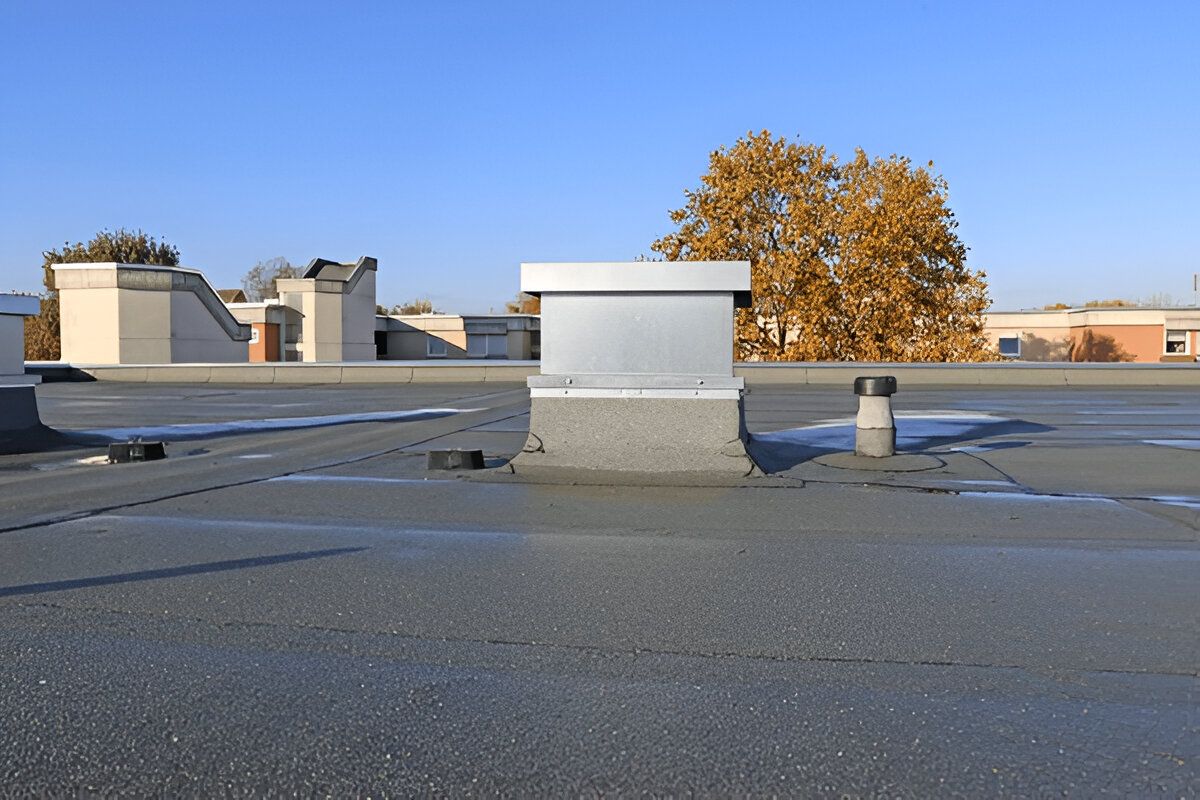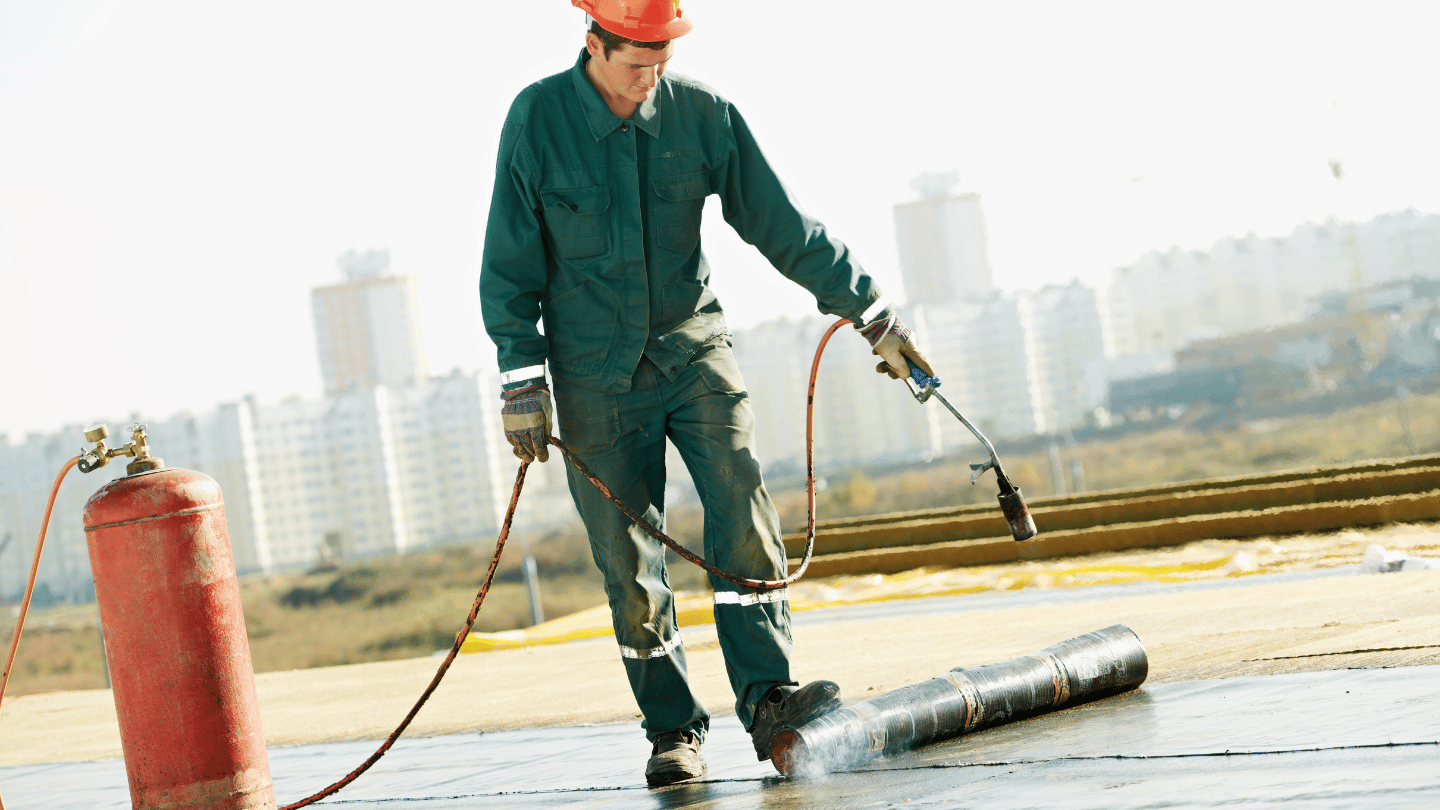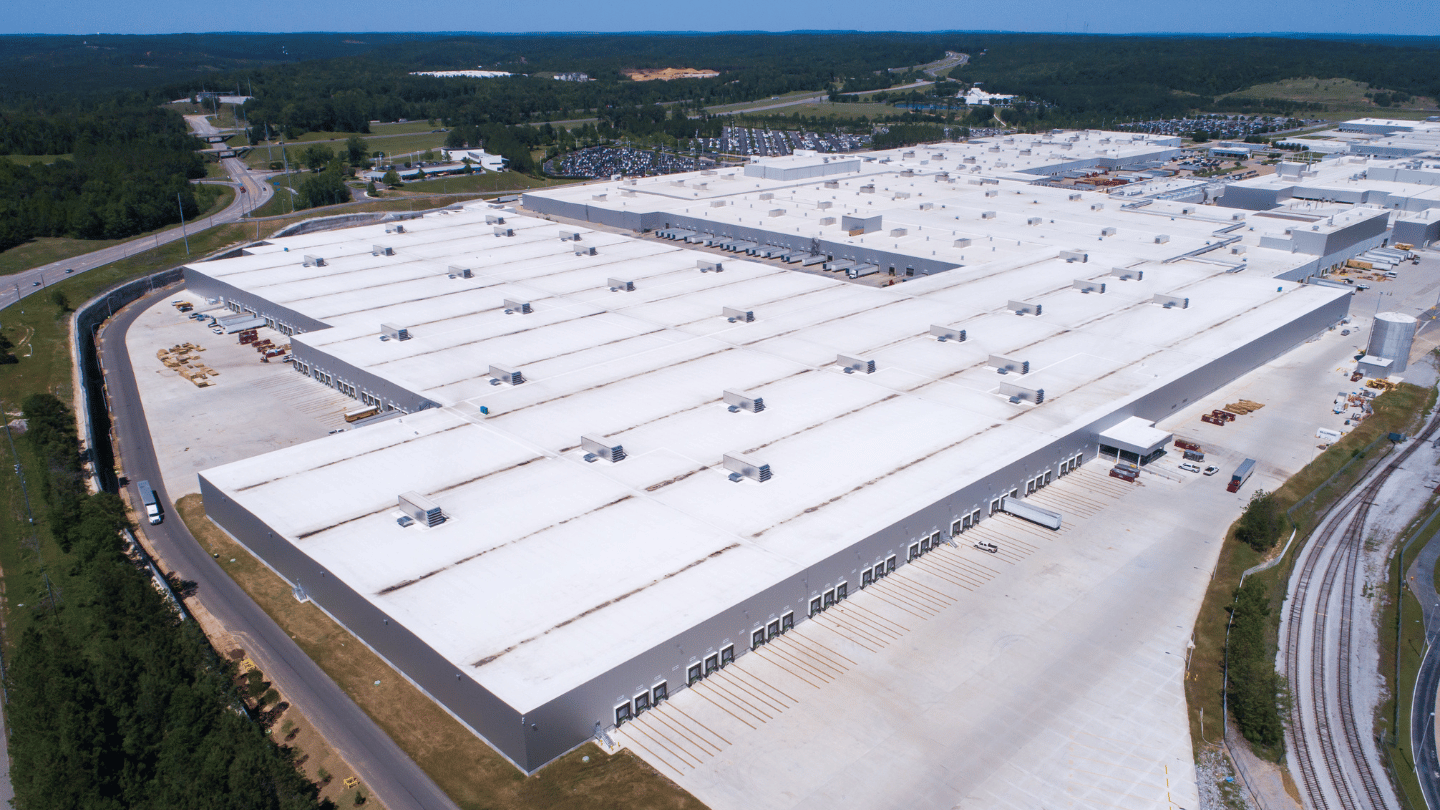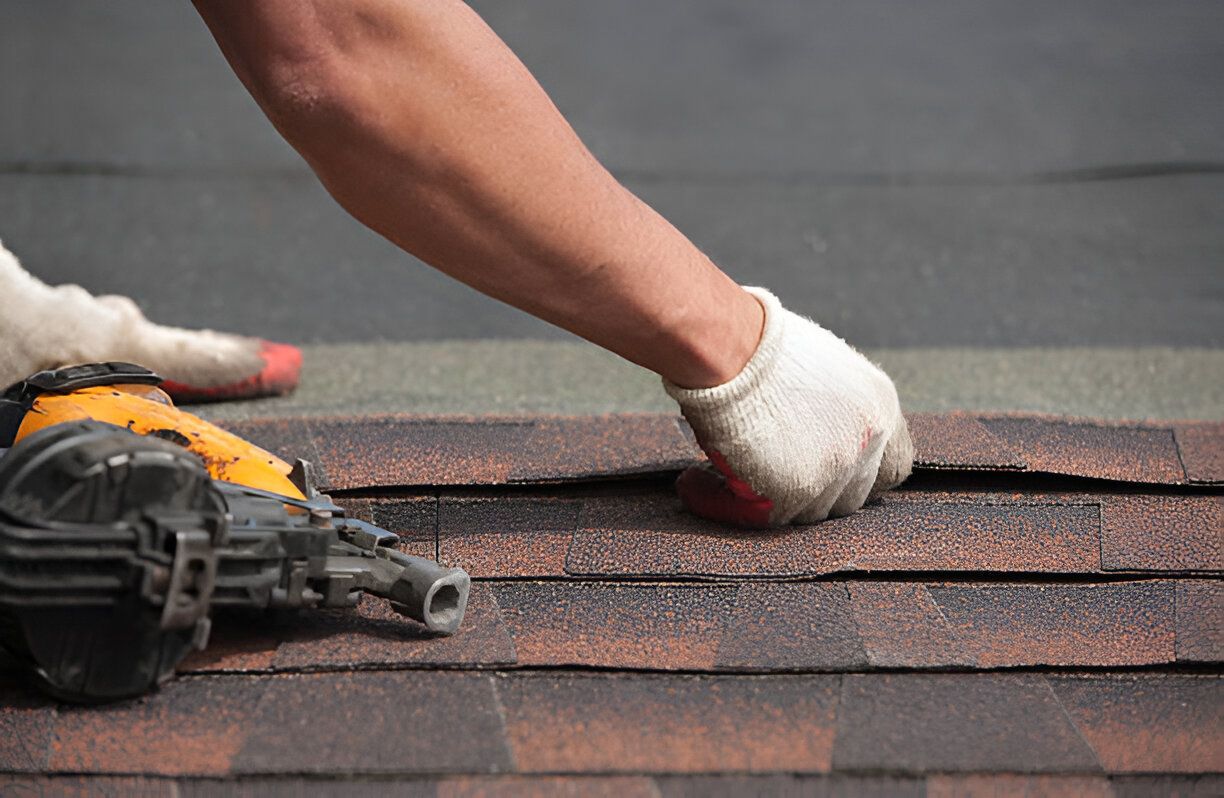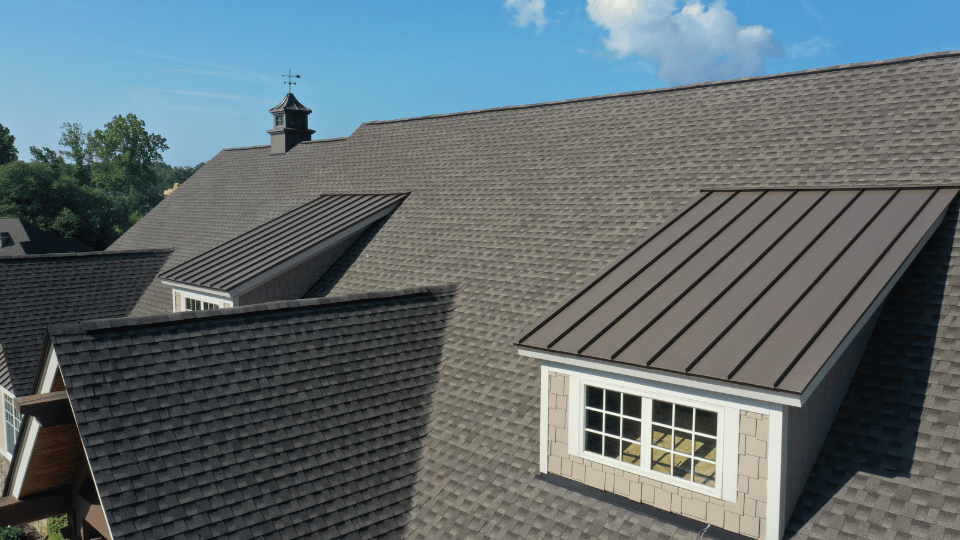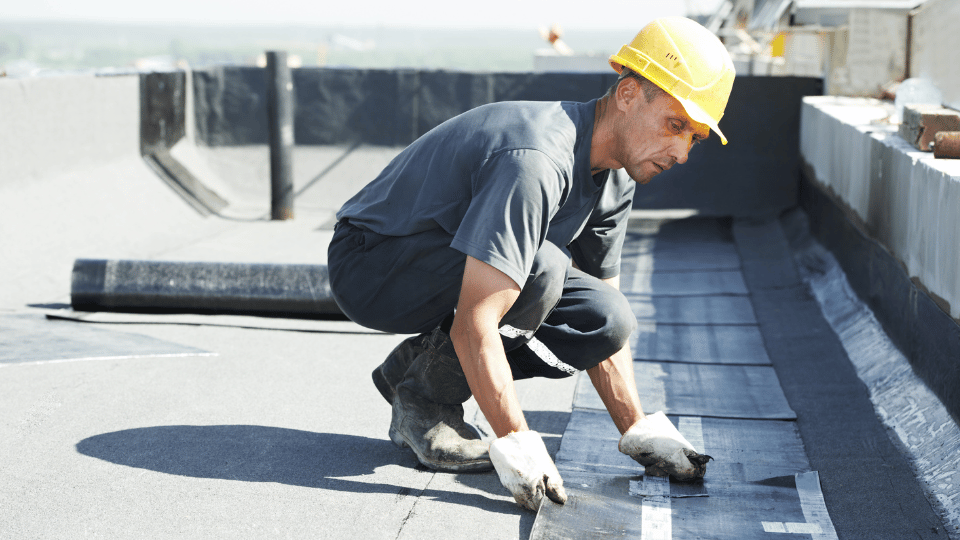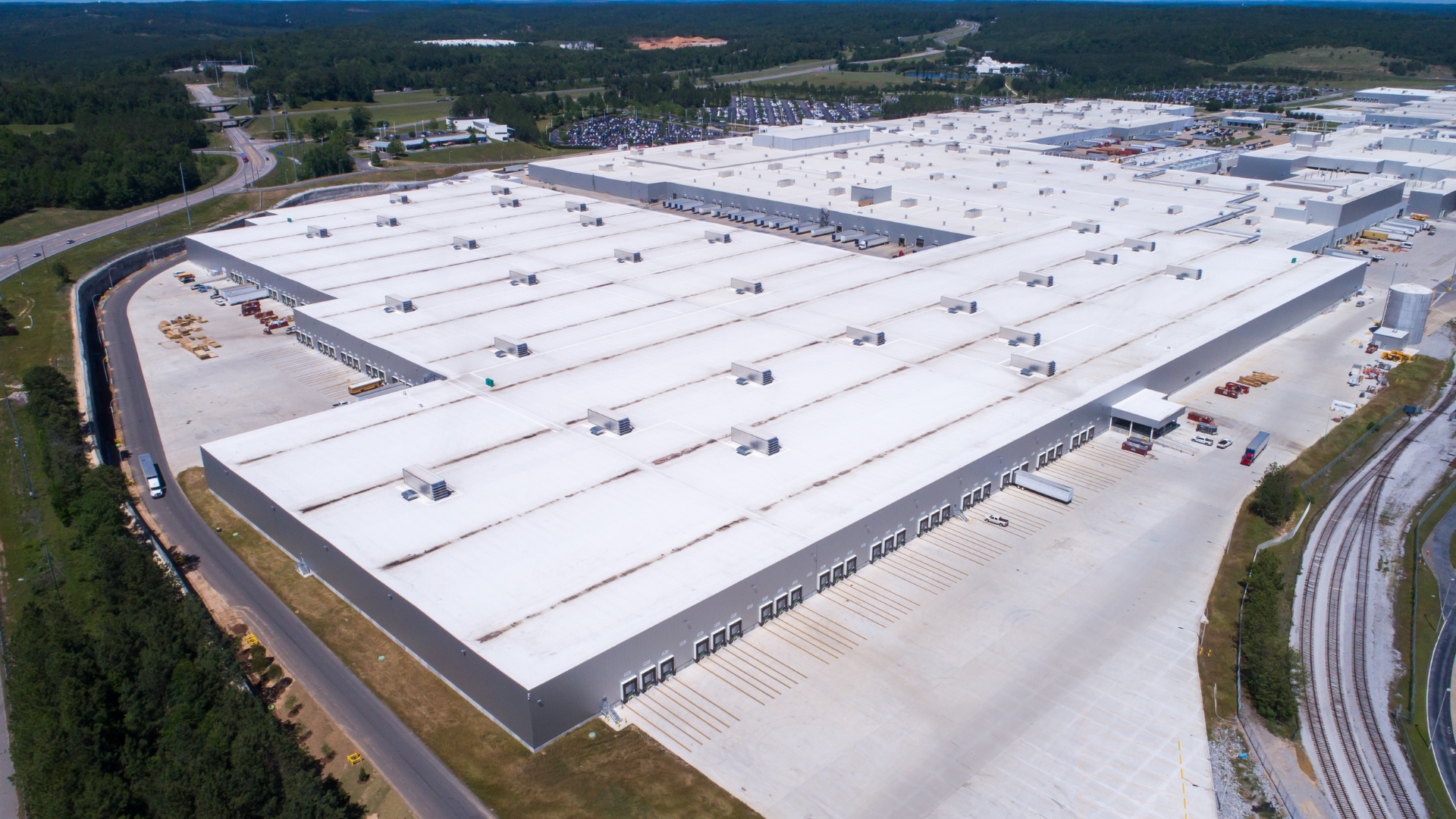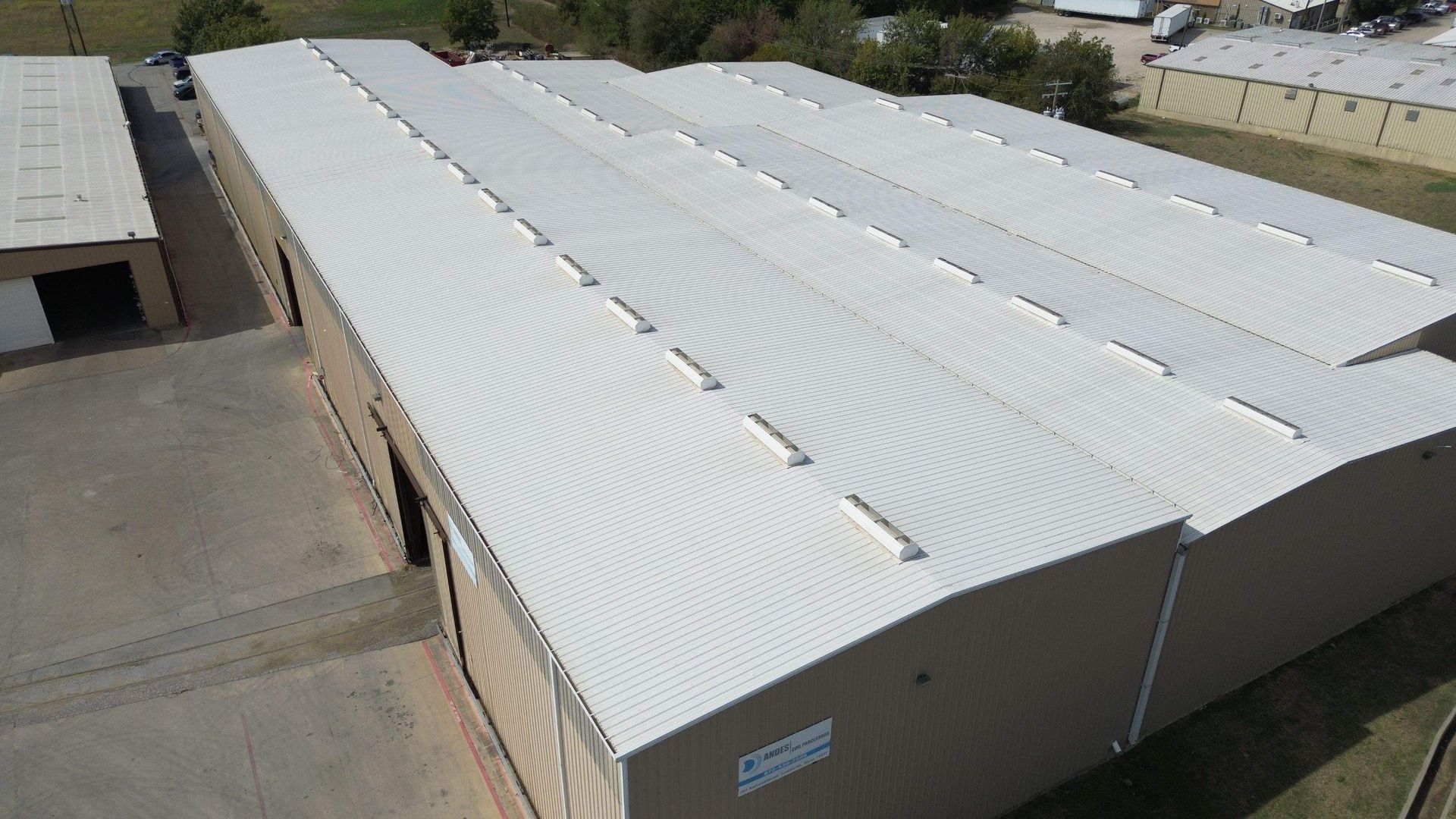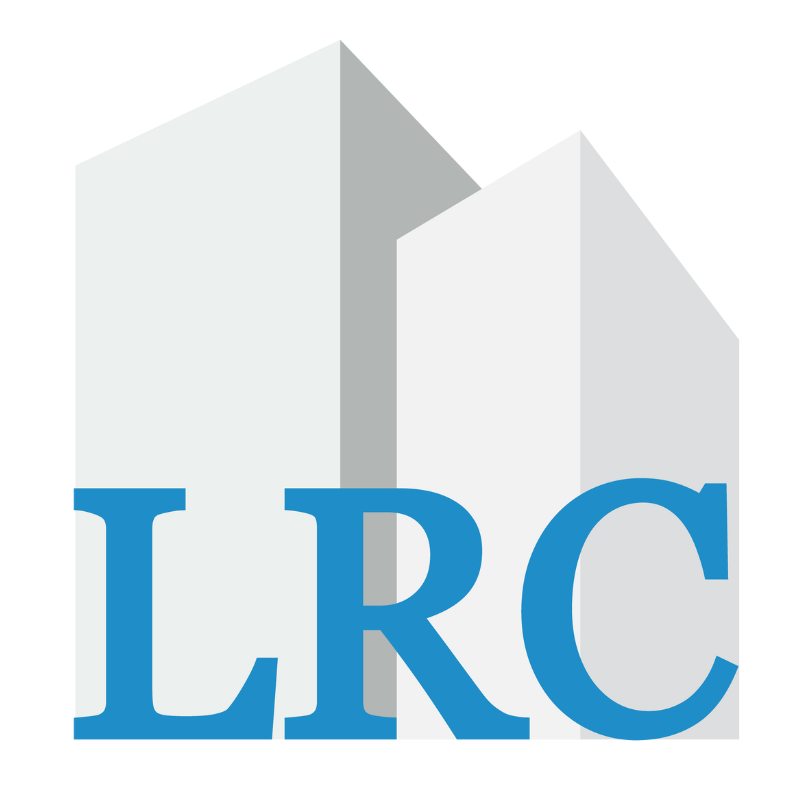CALL US NOW!

Flat Roof Replacement: Cost, Options & Tips for 2025
Need to replace your flat roof? Estimating the costs associated with a new flat roof involves considering various factors such as material choices and square footage. Discover costs, material options, and steps involved in flat roof replacement to plan your project effectively.
Key Takeaways
- Flat roof replacement costs average between $9,400 and $13,000, factoring in labor, materials, and additional expenses like permits.
- Choosing the right roofing material is crucial; options like TPO, EPDM, and modified bitumen roof vary in cost and longevity.
- Hiring a professional for flat roof replacement is often safer and more reliable than DIY, reducing the risk of poor installation and future issues.
Understanding Flat Roof Replacement
Definition of a Flat Roof
A flat roof is a type of roofing system that is almost level, with just a slight slope to facilitate water runoff. Unlike pitched roofs, flat roofs are designed to be nearly horizontal, making them a common choice for commercial buildings and modern residential homes, especially in regions with low rainfall.
The key to a successful flat roof is its waterproofing capability, achieved through a single layer of roofing material that covers the entire surface. This design not only provides a sleek, modern aesthetic but also allows for the efficient use of space, such as rooftop gardens or additional living areas.
Understanding Flat Roof Replacement Costs
Replacing a flat roof type involves several cost components, each contributing to the overall expense. On average, homeowners can expect to spend around $9,400 on flat roof installation, but this figure can go up to $13,000 depending on various factors. The flat roof replacement cost includes labor, materials, and additional expenses such as permits and inspections.
Roof removal is an essential initial step in the flat roof replacement process. It involves hiring professionals to ensure safety and efficiency, and it can significantly impact the overall cost. Homeowners should also consider the cost implications of debris and damage removal during this stage.
Several factors influence flat roofing costs, including the type of material used, labor expenses, maintenance requirements, and local weather conditions. These costs are vital for effectively budgeting and planning your roofing project.
Let’s break down these costs further into three main categories: labor costs, material costs, and additional costs.
Labor Costs
The installation of a flat roof usually incurs labor costs that span from $3 to $7 for each square foot, with variation arising from the project’s complexity and the proficiency level of the roofing contractor engaged. Roof repair, in particular, can also fall within this price range, with costs per square foot and hourly rates charged by roofers typically ranging from $40 to $80. Similarly, when removing an existing roof, you can expect labor expenses in the range of $3 to $7 per square foot. The type of material chosen for your roofing and how easily workers can access your roof may also affect these labor rates.
When it comes to hourly charges, roofing professionals typically set their fees between $40 and $80. These hourly rates contribute significantly to overall labor expenses which fluctuate based on the scale of your endeavor as well as any unique demands associated with installing your new roofing system. It is important to take into account all these elements when planning financial allocations for replacing your flat roof.
Material Costs
The choice of roofing materials significantly impacts the overall cost of a flat roof replacement. Options include TPO, EPDM rubber, modified bitumen roof, fiberglass, metal, and traditional asphalt. TPO roofing costs range from $3 to $14 per square foot, while EPDM rubber roofing ranges from $5 to $13 per square foot. Modified bitumen roof material costs between $4 to $8 per square foot and can last up to 30 years.
Built-up roofing (BUR) typically costs $4 to $10 per square foot, while aluminum shingles can range between $6.50 and $21 per square foot. Selecting the right material impacts both upfront costs and the roof’s longevity and maintenance needs. Weigh these factors carefully when choosing your flat roofing materials.
Additional Costs
When undergoing a flat roof replacement, one should anticipate several extra charges beyond the basic labor and material fees. Permits for roofing projects typically start at around $75. This fee may climb with an increase in roof size. Inspection costs associated with replacing a flat roof vary between $100 and $600. For removing an existing roof, expenses can be estimated within the range of $1 to $5 per square foot, leading to a general total removal cost that lies somewhere between $1,000 and $1,500.
The additional financial considerations could also originate from factors like the age and state of your current roof. Older roofs might necessitate more comprehensive repairs or even outright replacement, which amplifies overall costs. If there’s a need to replace drainage systems on flat roofs – expect potential outlays ranging from about $600 up to roughly $ 1,0000 as part of your expenditure calculations.
Types of Flat Roofing Materials
Choosing the right roofing material is crucial for the longevity and performance of your flat roof. Various flat roof materials and other flat roof materials are available, each with its own set of benefits and costs. The climate, building size, and budget are important factors to consider when selecting flat roofing materials.
Let’s explore some of the most popular options: TPO Roofing, EPDM Rubber Roofing, and Modified Bitumen.
TPO Roofing
Thermoplastic Polyolefin, commonly referred to as TPO, is a preferred option for flat roofing in both residential and commercial settings thanks to its affordability and ability to conserve energy. The price of installing TPO on flat roofs usually falls between $3 and $14 for every square foot.
TPO roofing is recognized for its capacity to reflect sunlight, which aids in lowering air conditioning expenses, particularly in warmer regions. With correct installation, this type of roofing has an expected lifespan of approximately 25 years.
EPDM Rubber Roofing
Renowned for its durability and resilience against harsh weather, EPDM rubber roofing, which stands for Ethylene Propylene Diene Monomer, provides a robust option suitable for both commercial and residential properties. The affordability of EPDM rubber roofing is evident as it typically falls between $4 to $13 per square foot.
In recent times, this cost-effective and long-lasting material has seen a surge in popularity due to the practical benefits it offers.
Modified Bitumen
Another outstanding choice for roofing is Modified Bitumen roofing, which is priced between $4 and $8 per square foot. This material is comprised of a five-layer structure that includes insulation, modified base sheets, the membranes of modified bitumen itself, adhesive layers, and surfacing.
These roofs are known for their durability and dependability on flat roofs with an expected longevity ranging from 15 to 30 years.
Built-Up Roof (BUR)
A built-up roof (BUR) is a traditional and time-tested flat roofing system that consists of multiple layers of roofing materials, typically alternating between asphalt or tar and reinforcing fabrics. These layers are built up on top of each other to create a durable and robust roofing system. BURs are favored for their ability to withstand heavy foot traffic and harsh weather conditions, making them a reliable choice for both commercial and residential flat roofs.
However, the installation process can be more labor-intensive and costly compared to other flat roofing options. Regular maintenance is essential to ensure the longevity and performance of a BUR, but its durability and resilience often justify the investment.
Steps in the Flat Roof Replacement Process
The process of replacing a flat roof entails numerous vital stages that require scrupulous attention to every detail. Initially, the procedure starts with an in-depth examination and dismantling of the current roofing system. Subsequently, there is the fitting of a new roofing structure. To conclude, conducting a final inspection is imperative to validate both quality and safety post-installation.
To understand these steps better, let’s explore each one individually.
Roof Inspection and Removal
The initiation of a flat roof replacement process involves roof removal as an essential initial step, along with an exhaustive assessment to detect any deterioration or problems. Particular scrutiny is directed towards vents and additional projections, which are typical sources of leaks. Maintaining safety during this stage is paramount in order to avoid mishaps.
Subsequently, the removal of the existing roofing materials takes place with care being taken to eliminate debris, mold, algae while fixing any harm inflicted on the surface. This provides a pristine and secure base for laying down the new roofing system. Despite being labor-intensive, this phase is critical in guaranteeing that the installation of the flat roof will be successful.
Installation of New Roofing System
The commencement of the new roofing system involves placing a fresh underlayment that serves as protection from moisture. Crafting the drip edge to fit precisely while on-site guarantees effective redirection of water away from sensitive parts of the roof. Modified bitumen systems are designed with efficiency in mind, employing overlapping sections to eliminate any potential for seam imperfections.
Depending on the size of the building and proficiency levels among contractors, installation times will vary. A smaller commercial structure might only require roughly five days, whereas larger edifices could demand anywhere between two to three weeks.
To complete this process, an expertly applied torch-down membrane provides an ultimate sealant layer, ensuring thorough coverage and creating a watertight barrier atop your building’s roof. Engaging professional services assures adherence to stringent safety protocols and diminishes chances for complications down the line.
Final Inspection and Maintenance Tips
After the installation, a final inspection is conducted to ensure the quality and safety of the new roofing system. This inspection typically costs between $120 and $300. The process includes a thorough check of the installation and clean-up of any debris to ensure everything is in order.
Proper maintenance extends the lifespan of the flat roof. Regular inspections and timely repairs significantly enhance the durability of roofing materials like EPDM rubber roofing, which can last up to 40 to 50 years with proper care. These maintenance tips help maximize your investment.
Permits and Inspections
Before embarking on a flat roof replacement project, securing the necessary permits and scheduling inspections with local authorities is crucial. Permits ensure that the roofing work complies with local building codes and regulations, safeguarding the structural integrity and safety of the building. Inspections, on the other hand, verify that the installation is performed correctly and meets all safety standards.
Neglecting to obtain the required permits and inspections can lead to significant fines, penalties, and even the need to redo the work, resulting in additional costs and delays. Therefore, it’s essential to factor in these requirements when planning your flat roof replacement.
DIY Flat Roof Replacement vs. Hiring Professionals
Many homeowners entertain the idea of undertaking a DIY flat roof replacement in an effort to cut down on labor expenses. Nevertheless, this decision can result in incorrectly installed roofing and possible safety risks.
Opting for a do-it-yourself route when replacing a flat roof may initially seem cost-effective, but it is advised to employ expert services for such tasks.
Risks of DIY Installation
Attempting to install a flat roof on your own carries considerable dangers, such as the risk of personal injury and the likelihood of incorrect installation. Flat roofs are especially vulnerable to leaking when they are not properly installed, and difficulties in ensuring adequate insulation can cause persistent problems.
Before embarking on a DIY flat roof installation project, it’s crucial to be cognizant of these potential risks.
Benefits of Hiring a Professional Roofing Contractor
Engaging the services of a roofing professional guarantees skilled craftsmanship, which diminishes the likelihood of encountering subsequent issues. Roofing experts extend warranties on their work, affording homeowners reassurance and possibly averting future repair expenses. By maintaining open lines of communication with the contractor during the job’s progression, homeowners remain apprised of any modifications that may arise from meteorological conditions or other unforeseen variables.
The pricing for expert roofing assistance mirrors the quality and expertise of the contractor and can lead to decreased cumulative costs over time as it typically necessitates less frequent repairs. By participating alongside professionals in non-essential tasks, homeowners have an opportunity to gain insight into their own roofing system.
Factors Influencing Flat Roof Replacement Decisions
Homeowners must consider multiple elements when deciding on flat roof replacement, such as the current state and age of their existing roof, budget constraints, and the local climate. Understanding these factors is crucial for making knowledgeable choices about roofing endeavors.
Age and Condition of Existing Roof
When determining whether to repair or replace a flat roof, the age and current state of the existing roof are essential considerations. Flat roofs usually need to be replaced after their expected lifespan of 20 to 30 years has elapsed. Indicators that a replacement may be required include typical problems like standing water, damage to the membrane, and structural issues with the roof itself.
Local Weather Conditions
The choice of roofing materials is greatly influenced by the specific climate conditions in a region. EPDM rubber roofing, for example, is particularly resilient against extreme weather events like heavy snowfall, strong winds, and hail storms. This makes it an ideal option for regions that experience severe weather patterns.
On the downside, black EPDM rubber membranes have a tendency to draw in heat which can lead to increased temperatures within living areas when it’s hot outside.
Budget and Financing Options
Homeowners considering a flat roof replacement must pay attention to budget limitations and the availability of financing choices. By investigating various financing avenues, homeowners can distribute the expense over an extended period, thereby easing the financial burden of the project. Options such as home improvement loans, personal loans, or lines of credit based on home equity present practical solutions for funding a flat roof replacement without incurring immediate economic hardship.
Utilizing these financial strategies enables property owners to commit funds towards vital repairs and replacements that will prolong their property’s lifespan and enhance its security. It is essential for homeowners to judiciously evaluate their finances while seeking out feasible financing alternatives to ensure that their flat roof replacement endeavor remains both cost-effective and successful.
Flat Roof Replacement vs. Repair
Deciding between a flat roof replacement and a repair depends on the extent of the damage and the age of the existing roof. Minor issues, such as small leaks or isolated areas of damage, can often be addressed with repairs. However, if the roof has extensive damage, frequent leaks, or is nearing the end of its expected lifespan (typically 20 to 30 years), a full replacement may be the more cost-effective and long-term solution. While a flat roof replacement represents a significant investment, it offers numerous benefits, including improved energy efficiency, enhanced property value, and reduced maintenance costs over time. Consulting with a professional roofing contractor can help determine the best course of action based on a thorough assessment of your roof’s condition.
Enhancing Energy Efficiency with Flat Roofs
Flat roofs present several possibilities for boosting energy efficiency, which is appealing for residential and commercial structures alike. By adopting strategies that promote energy efficiency, substantial reductions in utility expenses can be achieved while also elevating the comfort level within the building.
Investigate ways to augment the energy performance of flat roofs by utilizing reflective roofing materials, considering various insulation choices, and integrating green roofing systems.
Reflective Roofing Materials
Materials for roofing like TPO and PVC have the ability to reflect sunlight, which greatly diminishes heat uptake. This results in reduced indoor temperatures and less dependence on air conditioning systems. Roofs that are designed to be cool can bounce back a larger amount of sunlight while taking in minimal heat, thereby considerably reducing the temperature within buildings and their energy consumption.
By cutting down on how much energy is used, these reflective materials not only make it more economical to maintain comfortable conditions indoors, but also enhance the comfort level of the internal environment.
Insulation Options
Ensuring proper insulation is key to reducing heat loss during winter and mitigating heat gain throughout the summer, thereby improving the overall energy efficiency of a flat roof. High-performance insulation options like foam boards, mineral wool, and polyisocyanurate (PIR) boast excellent thermal properties that make them ideal for use in both warm and cold climates on flat roofs. By employing these materials, you can lower your energy expenses by cutting down on the necessity for additional heating or cooling.
Employing reflective roofing materials alongside robust insulation can substantially boost the energy efficiency of your building while simultaneously decreasing costs associated with heating and cooling systems. Adopting this strategy guarantees that your flat roof not only shelters your property, but also plays an integral role in fostering a more sustainable environment through enhanced energy conservation.
Green Roofing Solutions
Living roofs, comprised of a waterproofing layer crowned with plant life, bring both visual appeal and ecological advantages. There are primarily two varieties: extensive roofs adorned with low-maintenance, lightweight flora and intensive ones that can sustain a broader range of vegetation but require more upkeep. By promoting evaporation and reflecting solar rays, green rooftops contribute to the reduction of urban heat islands, resulting in cooler city settings.
Green rooftops not only enhance energy efficiency through added insulation, but also assist in controlling stormwater by absorbing precipitation. This capability helps diminish flooding threats by slowly reintroducing water into the drainage systems. The presence of green roofs prolongs the durability of the underlying waterproofing membrane by shielding it from detrimental weather elements.
Making an investment in a green roof could bolster your property’s environmental profile while potentially raising its value on the market.
Choosing the Right Roofing Contractor
When selecting the right flat roofing contractor for your flat roof replacement project, consider Lancaster Roofing in Flower Mound, Texas. Known for their commitment to quality and clear communication, Lancaster Roofing excels in managing commercial roofing projects, ensuring the job is done correctly, safely, and efficiently.
Let’s explore how to choose the right contractor by checking credentials and experience, reading reviews and testimonials, and requesting detailed quotes.
Checking Credentials and Experience
Ensuring that a contractor has the appropriate credentials and experience is crucial for high-quality and safe roofing work. Possessing certifications, such as GAF Master Elite, signifies commitment to industry standards and continuous education.
Confirming that the contractor holds proper licensing and insurance offers confidence in their dependability and expertise.
Reading Reviews and Testimonials
Examining online feedback and testimonials is crucial for assessing the dependability and craftsmanship of a roofing contractor. These customer accounts shed light on the various strengths and weaknesses in the services offered by a contractor, thereby assisting prospective clients to make educated choices.
A track record of persistent customer satisfaction serves as a strong sign that one is dealing with a credible roofing contractor.
Requesting Detailed Quotes
By obtaining detailed estimates from a variety of contractors, homeowners are equipped to make informed comparisons between the expenses and services on offer. It’s important to take into account the costs of materials, labor fees, and the warranties offered by each contractor during this comparison.
This approach guarantees that you secure optimal returns on your financial commitment toward replacing a commercial flat roof.
Summary
To sum up, the process of replacing a flat roof encompasses an assessment of various expenses, selecting suitable roofing materials and executing a meticulous installation procedure. The total cost is influenced by labor charges, material prices, and any unforeseen additional costs associated with the replacement of your flat roof. Opting for the correct roofing material—whether TPO, EPDM rubber or modified bitumen—can have significant effects on both the longevity and functionality of your new roof.
Engaging a qualified roofing contractor to undertake this task ensures superior craftsmanship while mitigating potential future complications. By taking into account elements such as how old the existing roof is and its current state, local climatic conditions as well as financing options at one’s disposal, homeowners are equipped to make knowledgeable choices about their flat-roof replacement endeavors. A strategic approach can greatly improve energy efficiency along with enhancing durability and visual appeal when updating your flat rooftop.
Frequently Asked Questions
What is the average cost of flat roof replacement in 2025?
The average cost for flat roof replacement in 2025 is around $9,400, but it’s wise to budget up to $13,000 for potential variations.
What factors influence flat roof replacement costs?
Flat roof replacement costs are influenced by the type of materials you choose, labor rates in your area, ongoing maintenance needs, and even local weather patterns.
It’s important to consider all these aspects to get an accurate estimate.
What are the benefits of hiring a professional roofing contractor?
Hiring a professional roofing contractor ensures expert workmanship and proper installation, along with the added peace of mind that comes from warranties.
It’s a smart choice for a safe and long-lasting roof!
What are some energy-efficient roofing options for flat roofs?
Consider using reflective roofing materials like TPO or PVC, along with good insulation and green roofing options, for an energy-efficient flat roof.
These choices can really help reduce your energy costs!
How can homeowners finance their flat roof replacement?
Financing your flat roof replacement can be done through home improvement loans, personal loans, or a home equity line of credit, helping you manage the costs more easily.
It’s worth comparing these options to find what works best for your budget!
Get Your Free Roofing Inspection
Thank you for contacting us.
We will get back to you as soon as possible.
Oops, there was an error sending your message.
Please try again later.
Seamless Roofing Solutions Are Just a Phone Call Away:
Talk to Us Today!
Please feel free to contact with us. We will aim to get back to you with 1-2 business days at the latest. Alternatively, feel free to call us now.


